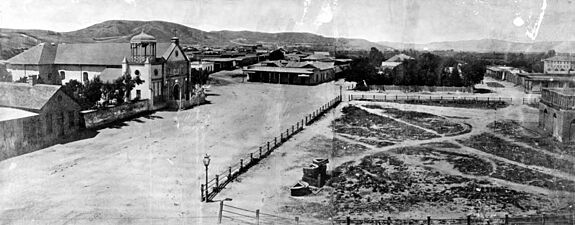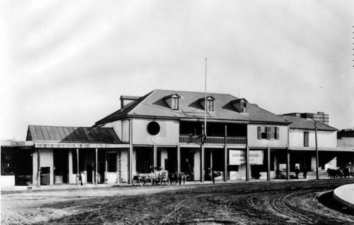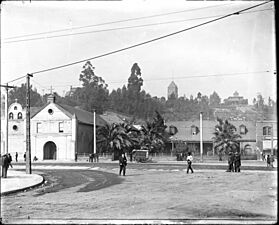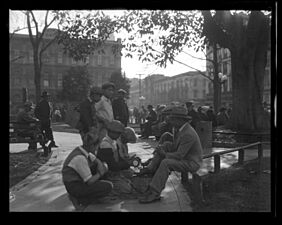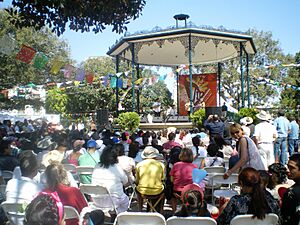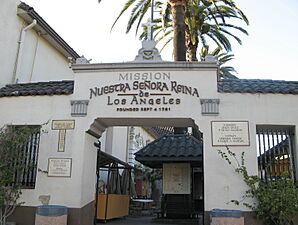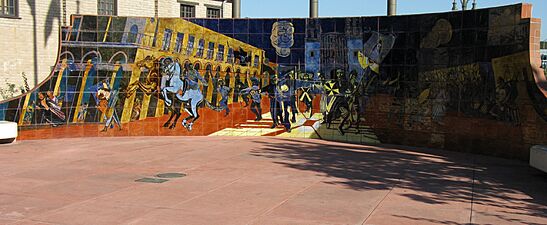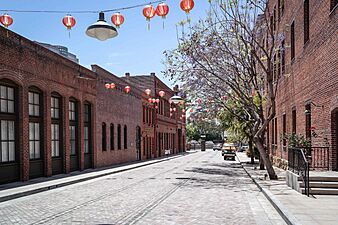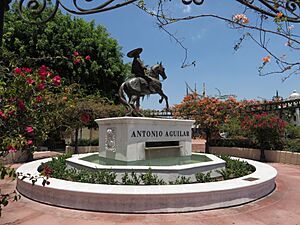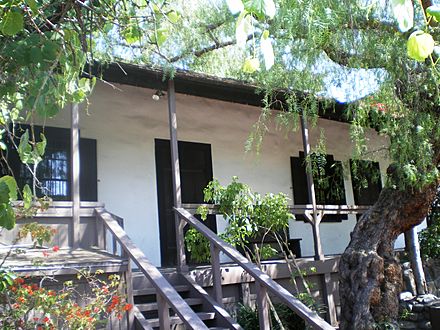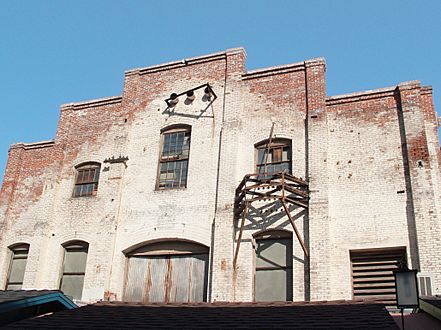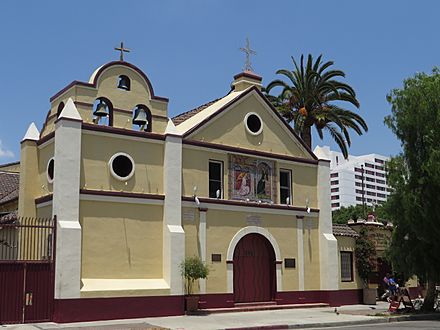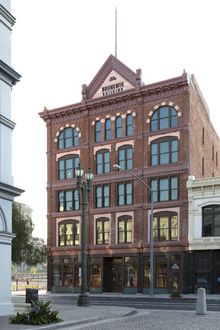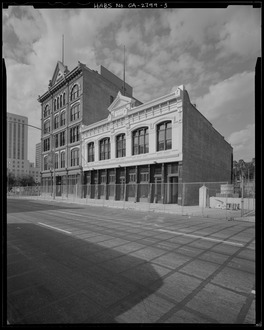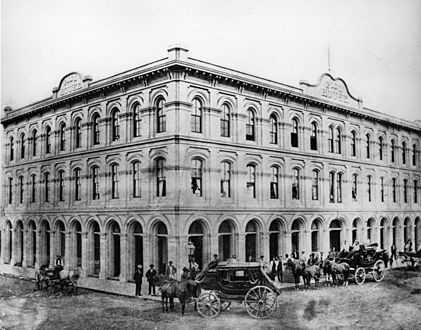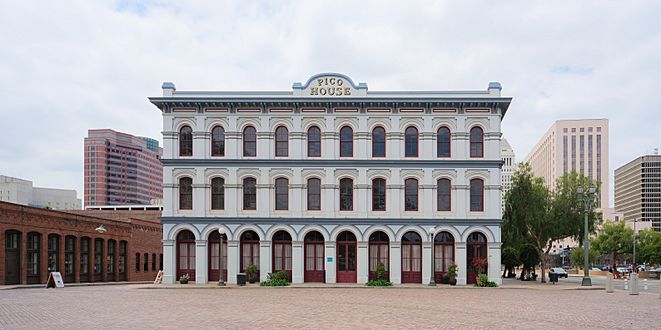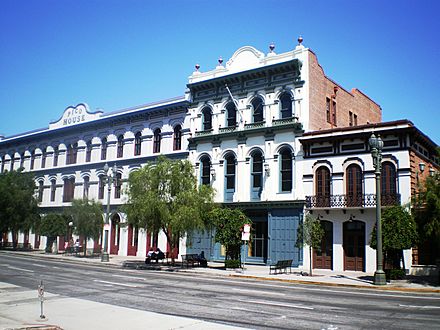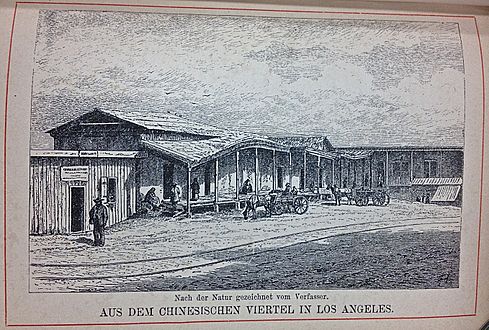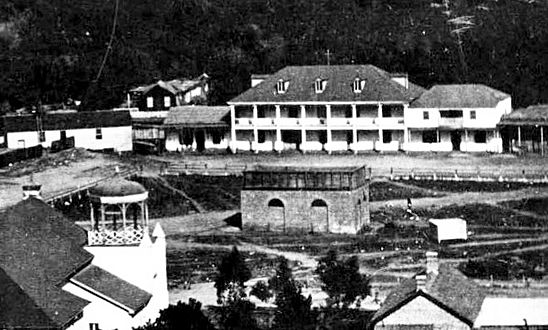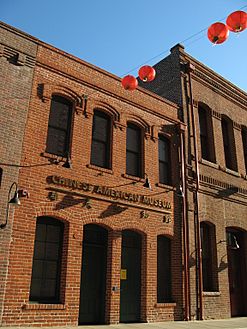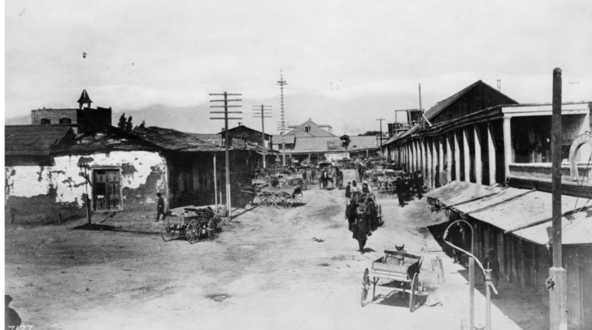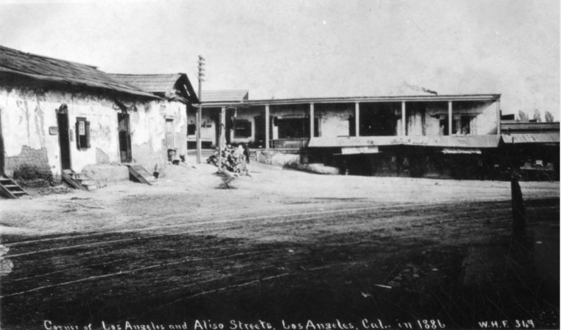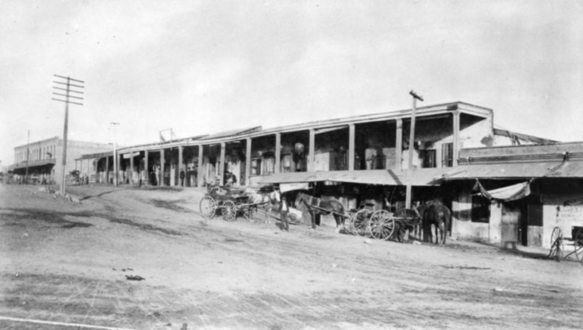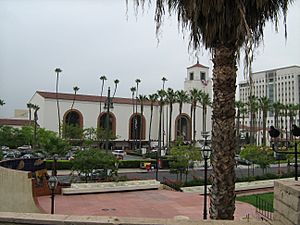El Pueblo de Los Ángeles Historical Monument facts for kids
|
Los Angeles Plaza Historic District
|
|
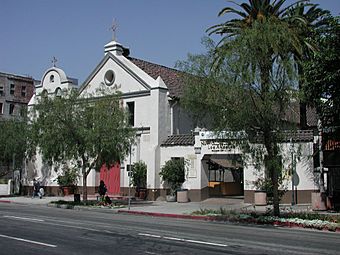
La Placita Church
|
|
| Location | Los Angeles, California |
|---|---|
| NRHP reference No. | 72000231 |
Quick facts for kids Significant dates |
|
| Added to NRHP | November 3, 1972 |
The El Pueblo de Los Ángeles Historical Monument, also known as the Los Angeles Plaza Historic District, is a special historic area in Los Angeles, California. It's the oldest part of the city! For many years, it was known by a long Spanish name: El Pueblo de Nuestra Señora la Reina de los Ángeles del Río de Porciúncula.
This historic district is built around the old plaza. This plaza was the main center of Los Angeles for a long time. It was important when Spain ruled (1781–1821), then when Mexico ruled (1821–1847), and even after the United States took over (after 1847) for most of the 1800s. This 44-acre park area became a state historic monument in 1953. It was also added to the National Register of Historic Places in 1972, which means it's recognized as a very important place in history.
Contents
- Historic images
- History of the Plaza District
- Protecting a Historic Park
- Modern Images of the Plaza District
- Important Places to See
- Part of Historic Trails
- Historic Map
- See also
Historic images
-
The Lugo Adobe (built 1840s, demolished 1950s) long anchored the east side of the Plaza
History of the Plaza District
How Los Angeles Began
A special plaque near the Old Plaza tells the story of how Los Angeles was founded. It says that on September 4, 1781, eleven families, called pobladores, arrived. There were 44 people in total, including children. They came from the Gulf of California to start a new town. This town would later become the big city of Los Angeles.
Many of these first settlers were Black. At least ten, and possibly up to 26, of the 44 founders were of African descent. Spain sent many African and mixed-race Catholic people to settle the California region.
King Carlos III of Spain ordered this settlement. Governor Felipe de Neve was in charge of making it happen. The small town was given a long Spanish name: El Pueblo de Nuestra Señora Reina de los Ángeles sobre El Río Porciúncula. This means The Town of Our Lady Queen of the Angels on the Porciúncula River.
The very first town was built a bit southeast of the current plaza. It was near the Los Angeles River and a Tongva village called Yaanga. In 1815, a big flood washed away the original town. So, it was rebuilt further from the river, at the spot where the plaza is today.
How the Pueblo Grew
For its first 70 years, the Pueblo grew slowly. In 1781, there were 44 people. By 1850, there were 1,615. That's about 25 new people each year. During this time, the Plaza Historic District was the main place for business and social life.
In 1850, California became part of the United States. Los Angeles officially became a city. The city grew very quickly in the 1880s and 1890s. The population jumped from 11,200 in 1880 to 50,400 in 1890, and then to 102,500 by 1900. As Los Angeles got bigger, its main business and cultural center started to move south, away from the Plaza.
Protecting a Historic Park
The area around the Plaza, which is about 44 acres (180,000 m2) (the size of 33 football fields!), has been saved as a historic park. It's generally bordered by Spring, Macy, Alameda, and Arcadia streets, and Cesar Chavez Boulevard. You can find a visitors center in the Sepúlveda House. A group of volunteers called Las Angelitas del Pueblo offers tours of the district.
This district has some of the city's oldest buildings, all grouped around the old plaza. Important historical buildings include the Nuestra Señora La Reina de Los Ángeles Church (built in 1822). The Avila Adobe (built in 1818) is the oldest house still standing in the city. Other famous spots are the Olvera Street market, Pico House (1870), and the Old Plaza Fire Station (1884). Four of these buildings have been fixed up and are now museums.
Scientists have also dug up old items in the Pueblo. These artifacts are from the time before Europeans arrived. They include animal bones, household items, tools, bottles, and pottery.
The district was named a state monument in 1953. It was added to the National Register of Historic Places in 1972. Even with these protections, some old buildings were torn down in the years that followed, especially those on the east side of the Plaza.
Modern Images of the Plaza District
Important Places to See
The Plaza Itself
The plaza is the very heart of the Historic District. It's seen as the birthplace of the city. It also separates the busy tourist area of Olvera Street from other buildings. Built in the 1820s, the plaza was once the main spot for shopping and social gatherings. Today, it still hosts many festivals and celebrations.
The plaza has large statues of two important people from the city's past. One is of Charles III of Spain, the king who ordered Los Angeles to be founded in 1780. The other is of Felipe de Neve, the Spanish Governor who chose the spot for the town and planned its layout. The plaza also honors the original forty-four settlers and the four soldiers who came with them. A big plaque lists their names, and smaller plaques for each of the eleven families are placed around the gazebo in the center of the plaza.
Buildings Around the Plaza
La Placita Church
The main church in the Plaza Historic District is called La Iglesia de Nuestra Señora la Reina de Los Ángeles. This means "The Church of Our Lady the Queen of the Angels." It was started in 1814, and the first building was finished in 1822. The church you see today was built in 1861. This church was one of the first three places in Los Angeles to be named a Historic Cultural Monument. It's also a California Historical Landmark.
Old Plaza Firehouse
The Old Plaza Firehouse is the oldest fire station in Los Angeles. It was built in 1884 and worked as a firehouse until 1897. After that, the building was used for many different things, like a store, a hotel, and a market. In the 1950s, it was fixed up. In 1960, it opened as a museum about firefighting.
Los Angeles Plaza Park
Los Angeles Plaza Park is an open grassy area within the plaza. It's where the Lugo Adobe used to stand before it was torn down. In June 2020, people protesting removed a statue of Father Junípero Serra. This was because of Serra's role during the time California was colonized.
Buildings on Olvera Street
Olvera Street is famous for its lively Mexican marketplace. It was once called Wine Street. In 1877, it was made longer and renamed after Judge Augustín Olvera, who was the first elected county judge in Los Angeles. Many of the historic buildings in the Plaza District, like the Avila Adobe and Sepulveda House, are on Olvera Street. In 1930, local shopkeepers turned it into the colorful market you see today.
Gallery
Avila Adobe
The Avila Adobe at 10 Olvera Street was built in 1818 and is the oldest surviving residence in Los Angeles. It was built by Francisco Ávila, a wealthy cattle rancher. Its adobe walls are 2½ to 3 feet (0.91 m) thick. U. S. Navy Commodore Robert Stockton took it over as his temporary headquarters when the United States first occupied the city in 1846. Listed on the National Register of Historic Places, the adobe is also designated as California State Landmark No. 145. It was restored starting 1926 through efforts by Christine Sterling, and now stands as a museum.
Sepulveda House
The Sepulveda House at 12 Olvera Street is a historic residence built in 1887 by Señora Eloisa Martinez de Sepulveda in the East Lake architectural style. The original structure included two commercial businesses and three residences. It has since then become a preserved museum, and is cited by its website as a representation of the "blending of Mexican and Anglo culture".
Eloisa Martínez de Sepúlveda was born in the state of Sonora in Mexico. She lived there until 1844 when her parents, Francisca Gallardo and Estaquio Martinez, moved to Alta California at the urging of Francisca’s brother, bringing the 11-year-old Eloisa and her older brother Luis, with them to Los Angeles. In 1847, Señora Francisca Gallardo received from the ayuntamiento (Common Council) a plot of land between Bath and Wine street (renamed Olvera Street in 1877) on which she constructed an adobe residence. Señora Gallardo’s adobe home at number 12 Bath Street was later enlarged to include by 1870 a second story and hipped roof. When Eloisa married Joaquin Sepulveda at the age of 23, she brought with her a dowry of land and cattle. Joaquin was an undistinguished member of an illustrious Southern California family. Sadly, the marriage suffered from misfortune as the couple’s only child died in infancy and Joaquin himself died in 1880 leaving no property. Señora Gallardo gave her property to her widowed daughter, Eloisa Martinez de Sepulveda, in 1881. On lands owned by her mother, Eloisa was able to finance the construction of a commercial building which provided her with a steady income. This was the Sepulveda Block, built in 1887.
Señora Eloisa Martinez de Sepulveda built the two-story Sepulveda Block in 1887 in response to the city’s real estate and population boom of the 1800s. The twenty-two room building cost $8,000 to erect. As her husband, Joaquin Sepulveda, had died seven years earlier leaving no estate, Señora Sepulveda probably financed the construction of the building on her own. By 1888 Bath Street had been renamed Main Street and the city had realigned and widened it, cutting off 18 feet (5.5 m) from the front of the adobe. Señora Sepulveda received $1,190 in compensation.
When the Sepulveda Block was built in 1887 Señora Eloisa Sepulveda kept a suite of three rooms for her own use. Her bedroom reveals much about her Mexican heritage and the popular tastes and styles of the time. It would also reflect some of the places in Los Angeles in the decades following her arrival from Sonora in 1844. The décor of the room shows a practical acceptance of modern technology and contemporary fashion, with its mass-produced walnut furniture and gaslight chandelier. The bedroom has three different wallpapers and a typical flowered carpet. The somewhat cluttered appearance is characteristic of the period and a sign of modest prosperity. By contrast, the brass bed with its draperies and fancy spread, the Chinese shawl, and the well-tended shrine are representative of Señora Sepulveda’s Mexican upbringing and her strong religious beliefs. The large crucifix is on loan from Señora Sepulveda’s descendants while the bed belonged to the Avila family, who were related to her by marriage. The pastel portrait is of her favorite niece, Eloisa Martinez de Gibbs.
Señora Sepulveda chose American architects George F. Costerisan and William O. Merithew to design her two-story business block for residential and commercial rental in 1887. Although this particular type of building is probably unique in Los Angeles today, it was a “pattern book” building of a style that was common all over the country at the time. An exception in this building is the typically Mexican breezeway which separates the Main Street stores from the dwelling rooms in the rear. Thus, the Sepulveda Block represents the transition in Los Angeles from Mexican to a combination of Anglo and Mexican styles. The work “block” is the Victorian term for a large commercial building. By this time the city had changed from a Mexican pueblo with a cattle-based economy to an American town with an agricultural economy. The population had grown from less than 2000, most of whom were Mexican, to over 50,000, only 19% of whom were Mexican. When the building was constructed it appears that Señora Sepulveda herself occupied the three residential rooms located in the rear, facing Olvera Street, then an unpaved alley. Later, she may have occupied other quarters. Commercial tenants were located in the stores fronting on Main Street while the second floor was used as a boarding house.
Señora Sepulveda bequeathed the building on her death in 1903 to her favorite niece and goddaughter, Eloisa Martinez de Gibbs. Edward Gibbs, an engineer and lumber company owner, had been a tenant in the Sepulveda Block. In 1888, the same year that he and Eloisa were married, Edward was elected to the City Council. Four of their five children were born in the second floor facing Main Street on the south side. In 1905, along with many other residents of the area, the Gibbs moved to a more fashionable neighborhood in Los Angeles. Succeeding generations of the Gibbs family operated the Gibbs Electrical Company and retained ownership of the Sepulveda Block until it was acquired by the State of California for $135,000 in 1958 as part of the Pueblo de Los Angeles State Historic Monument.
Between 1982 and 1984 major restoration took place in the Sepulveda Block. The building was structurally stabilized and plumbing, heating, air conditioning and electrical systems were installed. A new roof replaced the old one and the front staircase, which had been removed in the 1930s, was put back. The iron cresting is restored as are the red tin tiles over the bay windows. The west façade is “penciled” in the style of the period, meaning that the bricks are painted and mortar lines are traced in white on top. The east façade on Olvera Street, although not originally painted, had previously been sandblasted, a process which destroys the outer surface of the brick, making it porous. As paint provides bricks with protective coating, they have been painted with the color which was first used in 1919. A 1983 archeological excavation beneath the wooden floor unearthed artifacts relating to the building’s history. Peter Snell, partner with Long Hoeft Architects and Gus Duffy Architect, were the firms responsible for the Sepulveda Block restoration plans and construction supervision.
During World War II the Sepulveda Block became a canteen for servicemen and three Olvera Street merchants were located in the building. The building continued to be used by Olvera Street merchants until 1881 when they were relocated for the building’s restoration. Today, El Pueblo Park’s Visitor’s Center is located in the south store on the ground floor. This room represents the Victorian Eastlake style of 1890. Restoration plans call for the creation of an 1890s grocery store on the north side of the first floor.
Mural América Tropical
The mural América Tropical (full name: América Tropical: Oprimida y Destrozada por los Imperialismos, or Tropical America: Oppressed and Destroyed by Imperialism, ) by David Siqueiros, was unveiled above the street in 1932. It was soon covered up to mask its political content. The Getty Conservation Institute has performed detailed conservation work on the mural to restore it and the America Tropical Interpretive Center opened to provide public access.
Plaza Substation
The Plaza Substation, also at 10 Olvera Street, was part of the electric streetcar system operated by the Los Angeles Railway. Completed in 1904, the substation provided electricity to power the yellow streetcars. When the streetcar system closed in the 1940s, the building was converted to other uses. The substation is one of the two buildings in the district that is separately listed in the National Register of Historic Places. (The Avila Adobe is the other.)
Pelanconi House
Pelanconi House at 17 Olvera Street, built in the 1850s, is the oldest surviving brick house in Los Angeles. In 1924, it was converted into a restaurant called La Golondrina, which is the oldest restaurant on Olvera Street. The Pelanconi House was a winery producing wine from the grapes that grew in the area, possibly even inside the Avila Adobe where they grow currently. The DNA matches that of grapes at Mission San Gabriel, established in 1771.
Plaza Methodist Church
Built in 1926, the Plaza Methodist Church was built in 1926 on the site of the adobe once owned by Agustín Olvera, the man for whom Olvera Street was named. It is at the southeast corner of Olvera Street and Paseo de la Plaza (i.e. the Plaza).
Eugene Biscailuz Building
The former United Methodist Church headquarters, also built in 1926, was renamed in 1965 for Sheriff Eugene W. Biscailuz, who had helped Christine Sterling to preserve and transform Olvera Street. It housed the Mexican Consulate until 1991 and then the Mexican Cultural Institute.
Buildings on Main Street
Gallery (west side)
Gallery (east side)
-
Pico House in 1875
-
Pico House and the Plaza in 1876, photo taken from Fort Moore
-
Pico House today
-
Pico House, Merced Theater and Masonic Hall
Pico House
Pico House was a luxury hotel built in 1870 by Pío Pico, a successful businessman who was the last Mexican Governor of Alta California. With indoor plumbing, gas-lit chandeliers, a grand double staircase, lace curtains, and a French restaurant, the Italianate three-story, 33-room hotel was the most elegant hotel in Southern California. It had a total of nearly eighty rooms. The Pico House is listed as a California Historical Landmark (No. 159).
Masonic Hall
Masonic Hall at 416 N. Main St., was built in 1858 as Lodge 42 of the Free and Accepted Masons. The building was a painted brick structure with a symbolic "Masonic eye" below the parapet. In 1868, the Masons moved to larger quarters further south. Afterward, the building was used for many purposes, including a pawn shop and boarding house. It is the oldest building in Los Angeles south of the Plaza.
Merced Theater
The Merced Theater, completed in 1870, was built in an Italianate style and operated as a live theatre from 1871 to 1876. When the Woods Opera House opened nearby in 1876, the Merced ceased being the city's leading theatre. Eventually, it gained an "unenviable reputation" because of "the disreputable dances staged there, and was finally closed by the authorities."
Plaza House
This two-story building at 507–511 N. Main St. houses part of the LA Plaza de Cultura y Artes, which includes the Vickrey -Brunswig Building next door. It is inscribed on its upper floor, and on 1890s maps it is marked, "Garnier Block" (not to be confused with the Garnier Block/Building on Los Angeles Street, one block away). Commissioned in 1883 by Philippe Garnier, once housed the "La Esperanza" bakery.
Vickrey-Brunswig Building
This five-story brick building facing the Plaza at 501 N. Main St. houses LA Plaza de Cultura y Artes, which also occupies the Plaza House next door. It was built in 1888 and combines Italianate and Victorian architecture; the architect was Robert Brown Young.
Site of Sentous Building
The Sentous Block or Sentous Building (19th c., demolished late 1950s) was located at 615-9 N Main St., with a back entrance on 616-620 North Spring St. (previously called Upper Main St., then San Fernando St.). Designed in 1886 by Burgess J. Reeve. Louis Sentous was a French pioneer in the early days of Los Angeles. The San Fernando Theatre was located here. The site is now part of the El Pueblo parking lot.
Buildings on Los Angeles Street
-
Lugo Adobe lining the eastern edge of Los Angeles Plaza. The street in front of the adobe was part of Los Angeles St. starting in the 1880s. -
Chinese American Museum in the Garnier Building
-
1882 view, looking north from Broad Place along Calle de los Negros to the Ignacio Del Valle adobe in the far background. At left, with the peeling paint, is the Coronel Adobe (SE corner of Arcadia). A few years later, both adobes would be demolished and Los Angeles St. would be extended northward to (and past) the Plaza.
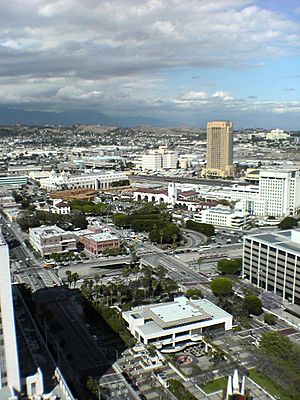
Northern end of Los Angeles Street
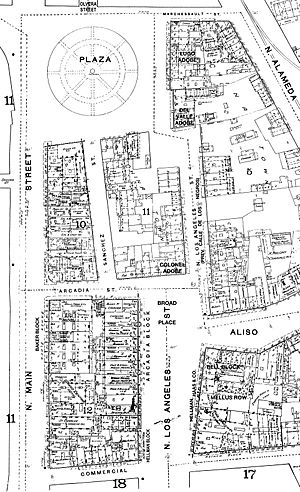
The Colonel Adobe was demolished in 1888 and 1896 Sanborn maps show that the Del Valle adobe had been removed, and Los Angeles Street had been extended to form the eastern edge of the Plaza, thus passing in front of the Lugo Adobe. Calle de los Negros remained for a few more decades, behind a row of houses lining the east side of Los Angeles Street between Arcadia and Aliso streets. This was also the western edge of Old Chinatown from around the 1880s through 1930s. It reached eastward across Alameda St. to cover most of the area that is now Union Station. It proceeded one more block past the Plaza, with the buildings on the east side of Olvera Street forming its western edge, until terminating at Alameda Street.
Eastern edge of Plaza
Since the early 1950s, Los Angeles Street has formed the eastern edge of the Plaza, but the buildings lining its eastern edge, including the Lugo Adobe, were removed. The site is now Father Serra Park.
From the Plaza north to Alameda
When it was extended past the Plaza in 1888, Los Angeles Street terminated one short block north of the Plaza at Alameda Street. Now, Los Angeles Street turns east at the north side of the Plaza to terminate at Alameda Street at a right angle, directly across from the Union Station complex. What was the short block of Los Angeles Street north of the Plaza is now part of Placita Dolores, a small open plaza which surrounds a statue of Mexican charro entertainer Antonio Aguilar on horseback.
Calle de los Negros
Until the late 19th century, Los Angeles Street did not form the east side of the Plaza; it ran south only from Broad Place at the intersection of Arcadia Street. Here, the Coronel Adobe blocked the path north one block to the Plaza, but just slightly to the right (east) of the path of Los Angeles Street was Calle de los Negros, a narrow, one-block north–south street likely named after darker-skinned Mexican afromestizo and/or mulatto residents during the Spanish colonial era. . At the north end of Calle de los Negros stood the Del Valle adobe (also known as the Matthias or Matteo Sabichi house), at the southern edge of which one could turn left and enter the plaza at its southeast corner. Calle de los Negros was famous for its saloons and violence in the early days of the town, and by the 1880s was considered part of Chinatown, lined with Chinese and Chinese American residences, businesses and gambling dens.
By 1871, the alley was notorious as a "racially, spatially, and morally disorderly place", according to historian César López. It was here that a growing number of Chinese immigrant railroad laborers settled after the completion of the transcontinental railroad in 1869. There, William Estrada notes, the "Chinese of Los Angeles came to fill an important sector of the economy as entrepreneurs. Some became proprietors and employees of small hand laundries and restaurants; some were farmers and wholesale produce peddlers; others ran gambling establishments; and some occupied other areas left vacant by the absence of workers in the gold rush migration to California." The Chinese population increased from 14 in 1860 to almost 200 by 1870. Guinn stated that the alley stayed "wicked" through and after its transition to the city's Old Chinatown.
Calle de los Negros was reconfigured in 1888 when Los Angeles Street was extended north, with a small, shallow row of houses remaining between the new section of Los Angeles street's eastern edge and the western edge of the new, shortened alley. The site of Calle de los Negros is now the Pueblo parking lot and a cloverleaf-style entrance to the US 101 freeway.
Coronel Adobe
The Coronel Adobe was built in 1840 by Ygnacio Coronel as a family home. It stood at the northwest corner of Arcadia Street and Calle de los Negros; Los Angeles Street terminated at its southern end. The area gradually became an area for gambling and saloons, and upper-class families left to live elsewhere. Around 1849, they sold the house to a "sporting fraternity", which operated a popular 24-hour gambling establishment with games including monte, faro, and poker; up to $200,000 in gold could be seen on the tables at a time. After that, still in the 1850s, it became a grocery and dry goods store (Corbett & Barker), then a storage house for iron and hard lumber for Harris Newmark Co. It was then leased to a Chinese immigrant. In 1871, it was the site of the Chinese massacre of 1871. The Adobe was torn down in 1888 in order to extend Los Angeles Street north past the Plaza.
Garnier Building
At 419 N. Los Angeles Street, at the northwest corner of Arcadia, is the Garnier Building, built in 1890, part of the city's original Chinatown. The southern portion of the building was demolished in the 1950s to make way for the Hollywood Freeway. The Chinese American Museum is now located in the Garnier Building. It should not be confused with another Garnier Block/Building on Main St. a block away now commonly known as Plaza House.
Historical Mural Painting
You can see a colorful mural painting that looks like real life. It shows different important historical events from Los Angeles.
Part of Historic Trails
Juan Bautista de Anza National Historic Trail
The Pueblo de Los Ángeles is a stop on the Juan Bautista de Anza National Historic Trail. This trail is part of the United States National Trails System, managed by the National Park Service. You can follow a driving tour map to visit different places along the trail.
Old Spanish National Historic Trail
The Pueblo de Los Ángeles was the final stop on the Old Spanish Trail. This trail became a National Historic Trail in 2002. Museums, historic sites, and markers along the Old Spanish Trail show places from Santa Fe to Los Angeles. The visitor center at the Avila Adobe offers a special stamp for your National Park Passport for this trail.
Historic Map
Below is a map of the Plaza area with streets and monuments marked as they appeared in the 1880s.
Abbreviations and notes
- Italics indicate buildings that are still standing.
- Buildings not in italics were demolished.
- A dagger (†) indicates a street that no longer exists, or the pedestrianized areas, formerly considered streets on the perimeter of and now considered part of the Los Angeles Plaza.
*now Cesar Chavez Ave. **later Sunset Bl., Now Paseo Luis Olivares
| SHORT/BELLEVUE/SUNSET* | Sentous Block (1886–1950s) | M A I N S T R E E T |
MACY | L O S A N G E L E S S T R E E T |
MACY | A L A M E D A S T. |
MACY | ||||
| Upper Main St. (San Fern- ando St., North Spring St.) |
Pelanconi House (1850s) La Golondrina restaurant (1924– ) Sepulveda House (1887) |
O L V E R A S T. |
—Avila Adobe (1818) —Plaza Substation (1905) —Olvera House (19th c.)/ —Methodist Church and Eugene Biscailuz Bldg. (1926) |
"Female Boarding" | Orphan Asylum APABLAZA ST. Old Chinatown Now Union Station (1939) |
||||||
| MARCHESSAULT ST.†** | MARCHESSAULT ST.† | MARCHESSAULT† | MARCHESSAULT† | ||||||||
| —Our Lady Queen of the Angels Church (1814/1861) Plaza House (1883) —Vickrey-Brunswig Bldg (1888) |
LOS ANGELES PLAZA | —Lugo Adobe (1840s-1951) | Chinese theater |
Old Chinatown Now Union Station |
|||||||
| Now Fr. Serra Park. Del Valle adobe (?-1880s) |
"Female boarding" | ||||||||||
| SONORA/REPUBLIC† | PLAZA STREET† | FERGUSON† | SHAFER† | ||||||||
| Hoffman House (hotel) | Carrillo House (1821-1869)/ Pico House (1875) Merced Theater (1870) |
S A N C H E Z |
—Chinese American Museum in the Phillipe Garnier Bldg.(1890) At corner: —Coronel Adobe (1840-1888)/ —Hotel Lion D'Or in Jeanette Block |
Calle de los Negros —"Female Boarding" —"Chinese Quarters" Wilcox Bldg./ —Hotel Grenoble/ —Hotel De Gap Now parking lot and freeway onramp. |
—"Female Boarding" —Hotel de France Now Union Station complex. |
||||||
| Now US 101 | ARCADIA now Arcadia St. & US-101 | ALISO now Arcadia/US-101 | |||||||||
See also
 In Spanish: El Pueblo de Los Ángeles para niños
In Spanish: El Pueblo de Los Ángeles para niños
- List of Registered Historic Places in Los Angeles
- History of Los Angeles
- Fort Moore Pioneer Memorial
- LA Plaza de Cultura y Artes
- Mariachi Plaza
- Pueblo de Los Angeles




